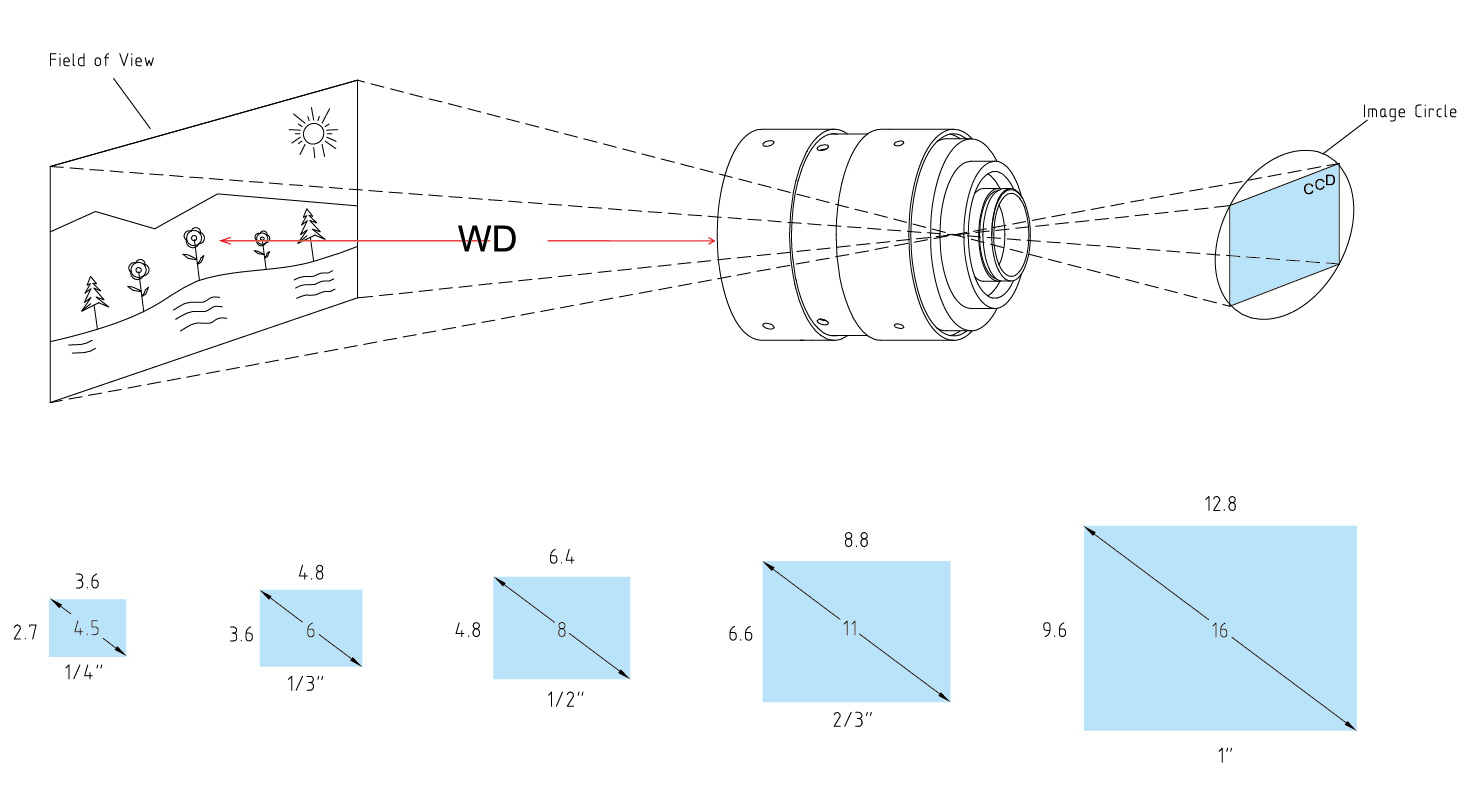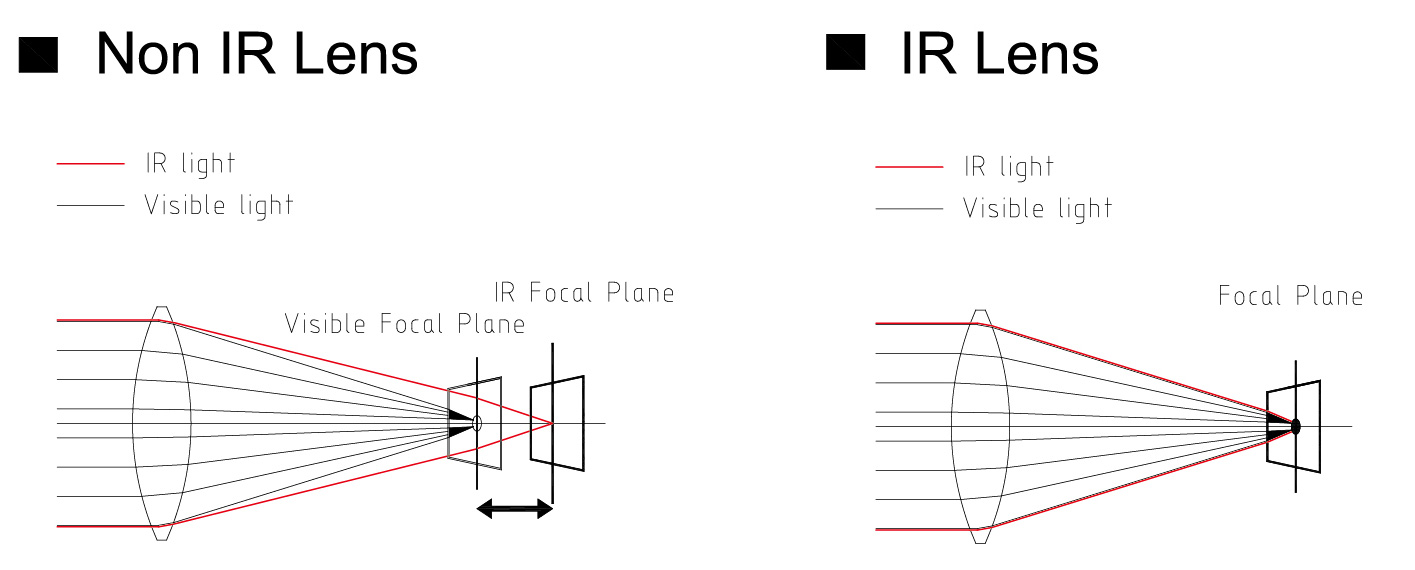Image size
CCTV cameras come in a variety of different sensor sizes, and the screen aspect ratio is usually 4:3 (horizontal width: vertical height). The size of the sensor has an effect on the field of view, using the same lens on a smaller sensor has a narrower field of view. The specification of the lens has nothing to do with the field of view, it is simply necessary to make the image cover the entire sensor, i.e. the same size or larger specification of the camera. This also means that a 1/3" camera can use all lenses from 1/3"- 1/", e.g. a 1/3" 12mm lens has the same field of view as a 2/3" 12mm lens. The latter has improved image pixel and image quality because only the center portion of the lens is obtained, and images in this range are usually sharper.

monitoring range
Light rays from an infinite object distance converge inside the lens at a common point on the optical axis. That point where the sensor of a closed circuit surveillance camera focuses is called the focal point. In optical design, a lens has 2 primary points, a primary primary point and a secondary primary point, and the distance between the secondary primary point and the focal point determines the focal length of the lens.

field of view
The field of view is the angle of the line from the lens to the edge of the image sensor. Theoretically, the focal length of a lens is fixed and the field of view is fixed when the image plane size of the camera is not taken into account. But in practice, the size of the field of view will also change with the size of the phase plane. When the size of the phase plane is fixed, if the focal length becomes shorter, the field of view becomes larger accordingly. The focal lengths in the catalog are rated focal lengths, so the field of view calculated by the formula is an estimate.

aperture
It is an index that measures the amount of light passing through the lens. The aperture value is represented by the F-value, the smaller the F-value, the greater the luminous flux, and the brighter the image formed by the lens.The F-value is inversely proportional to the aperture of the lens, and directly proportional to the focal length.
The ratio formula is as follows:
F value = f / D (f: focal length, D = lens aperture)
Auto Iris vs Manual Iris
Lens is roughly divided into DC drive iris, video drive iris, manual iris three. DC drive aperture is controlled by the internal circuit of the lens, the video drive aperture is equipped with an internal amplifier, which is controlled by the video signal and the DC power provided by the camera. Manual aperture is realized by the lens external adjustment ring to manually adjust the aperture change.
depth of field
Depth of field means that after the camera lens focusing is completed, in the focus before and after the range can form a clear image, this one before and after the distance range, it is called the depth of field.
Aperture, lens, and distance from the subject are important factors in depth of field:
1. The larger the aperture the smaller the depth of field, the smaller the aperture the larger the depth of field.
2. The longer the focal length of the lens, the smaller the depth of field, and vice versa.
3. The closer the subject, the smaller the depth of field, and the farther the subject, the larger the depth of field.
4. The depth of the near field is greater than the depth of the far field.

closest object distance
The closest object distance is the distance from the center point of the lens at the very front of the lens to the nearest object that can be clearly imaged.
CS and C interfaces
The rear flange distance of CS interface lens is 12.5mm, and the rear flange distance of C interface is 17.5mm. CS interface lens can only match CS interface camera, but C interface lens can match C interface lens in addition to adding a 5mm C to CS adapter to match CS interface camera.
Rear Flange Distance, Rear Focal Length, Mechanical Rear Focal Length
The rear flange distance is the distance from the lens connector to the camera sensor.
The back focal length is the distance from the center point of the last lens of the lens to the camera sensor.
The mechanical back focal length is the distance between the very front of the lens interface and the camera sensor.

Non-IR Lenses vs. IR Lenses
Day and night cameras are generally used at night in near infrared or infrared environments. If a lens without IR correction is used with a day/night camera, the camera will not be able to focus clearly at night. EVETAR lenses use glass lenses with special optical design and multi-layer coating to reduce the refraction of light to achieve day and night co-focus. This eliminates the need to refocus the camera when it is used at night.

megapixel
CCD and CMOS image sensors utilize pixels arranged in a two-dimensional grid. These pixels convert an optical image into an electronic signal. The number of pixels in an image usually determines the resolution of the image, and more pixels means higher resolution. A megapixel is one million pixels. A megapixel camera is a camera that uses a megapixel sensor.
